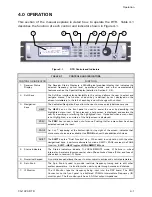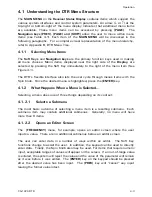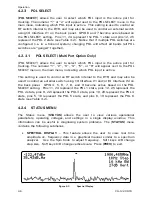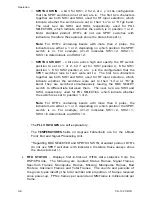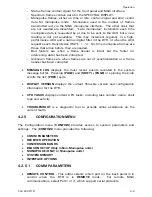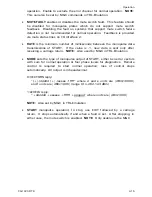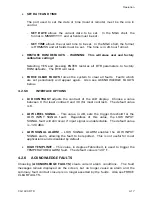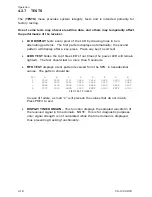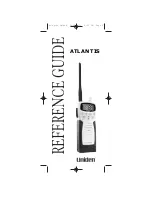
Operation
4-12
CG-1220 DTR
DAC1 and DAC2 SETUPS
– DAC1 provides an analog DC voltage
proportional to signal level on pins 1 and 14 (+OUT, -OUT) of I/O
Interface #1 on the back panel. DAC2 provides an analog DC voltage
proportional to signal level on pins 3 and 16 (+AUX, -AUX) of I/O
Interface #1 on the back panel. See Section 3.5.1 for DAC setup
information. Both DAC1 and DAC2 SETUPS have the following
submenus:
VOLTAGE RANGE
selects the DC voltage range of the DAC. This
value is used to represent the signal level as a tracking voltage
MINIMUM REFERENCE POWER LEVEL
sets the minimum input power
level reference which corresponds to minimum DAC voltage output.
SLOPE
controls the rate of change of the DC output with respect to a
1 dB change in signal power level. Select a value from -1.000 to
1.000 V/dB.
OUTPUT
enables or disables the respective DAC output, DAC1 or
DAC2.
UPDATE RATE
, in milliseconds, is used by the DSP to send the current
signal level to both DAC1 and DAC2 outputs. Notice that the VOLTAGE
RANGE, MINIMUM REFERENCE POWER LEVEL, and SLOPE may be
independently set up. However, the UPDATE RATE applies to both DAC
outputs.
A
TTENUATION controls the lower end of the Digital to Analog Converter
(DAC) voltage output, in conjunction with the parameters in the DAC1
and DAC2 setups. The range is from 0 to 50 dB. Rotating the spin knob
clockwise, for example, increases the apparent attenuation, resulting in a
lower voltage level output; actual input power is not affected. NOTE:
This parameter will affect both DAC1 and DAC2. Also, this parameter is
not intended to compensate for signal overload conditions. If signal
overload occurs, use parameter INPUT ATTEN from the MAIN MENU.
FFT SAMPLE AVERAGING
determines how new FFT data is combined with
previous data. Increasing AVERAGING smoothes the spectral curve and
increases the stability of the display. Decreasing AVERAGING improves the
DTR response time.
Detection (WIDEBAND OPTION ONLY)
Receivers
with
the
Wideband
option have four detection modes:
1.
FFT Signal – (Default) Detects and sums together all signals, within the
selected bandwidth,
that are above the estimated noise floor. This mode
is useful when detecting narrow band signals, narrow with
respect to the bandwidth selected.
Summary of Contents for CG-1220
Page 6: ...vi THIS PAGE INTENTIONALLY LEFT BLANK...
Page 10: ...Table of Contents x THIS PAGE INTENTIONALLY LEFT BLANK...
Page 16: ......
Page 54: ...Maintenance 5 4 CG 1220 DTR THIS PAGE INTENTIONALLY LEFT BLANK...
Page 56: ...Engineering Drawings 6 2 CG 1220 DTR THIS PAGE INTENTIONALLY LEFT BLANK...
Page 65: ...Appendix C DTR Remote M C Protocol CG 6073 Rev R Jun 2012 4 THIS PAGE INTENTIONALLY LEFT BLANK...
Page 130: ...Remote M C Protocol C 2 CG 1220 DTR THIS PAGE INTENTIONALLY LEFT BLANK...
Page 134: ...Acronyms Abbreviations D 4 CG 1220 DTR THIS PAGE INTENTIONALLY LEFT BLANK...




